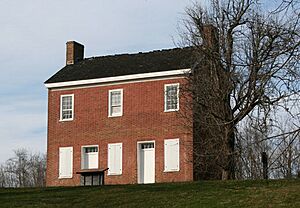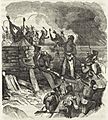John Gordon (militia captain) facts for kids
Quick facts for kids
John Gordon
|
|
|---|---|
| Born | July 15, 1759 Spotsylvania County, Virginia |
| Died | June 6, 1819 (aged 59) Gordon House, Hickman County, Tennessee |
| Allegiance | United States of America |
| Service/ |
Tennessee militia |
| Rank | captain |
| Battles/wars | Creek War, Battle of Talladega, Battle of Horseshoe Bend, Battle of Pensacola |
| Other work | pioneer, planter, land speculator |
John Gordon (born July 15, 1759 – died June 6, 1819) was an American pioneer and military leader. He was an early settler in the Nashville, Tennessee area. Gordon became a captain in the Tennessee Militia.
He fought against the Creeks and Seminoles during the War of 1812. General Andrew Jackson called him his "Captain of the Spies." Gordon also helped improve the Natchez Trace, an important trail for settlers. He played a key role in battles like the Battle of Horseshoe Bend and the capture of Pensacola.
Contents
John Gordon's Early Life and Moving to Tennessee
John Gordon was born in Spotsylvania County, Virginia. His family owned a lot of land. His father fought in the American Revolutionary War. After the war, his family moved to Nashville.
As a young man, John Gordon became known as a fighter against Native American groups. He rode with the militia to check on attacks near Nashville. In 1793, he became a captain in the militia. In 1794, he joined the Nickajack Expedition. This campaign was against the Chickamauga Cherokee. They were defending their homeland in the Tennessee River Gorge.
After Tennessee became a state in 1796, Gordon was its first postmaster. His son-in-law, Felix Zollicoffer, later held this job too. Gordon owned a large farm in Nashville. He made money from horse racing. He later had to sell some land because of debts. Gordon married Dorothea "Dolly" Cross. Her family also came from Virginia. Both John and Dolly were related to Pocahontas.
Gordon's Later Career and Adventures
Gordon became friends with the Chickasaw Native Americans while in the militia. He kept these friendships throughout his life. Later, he bought land in what is now Hickman County, Tennessee. This land was on the Duck River. Here, he started a large farm of over 1,500 acres.
His land was important because the Natchez Trace crossed the Duck River there. The Natchez Trace was an old Native American trail. Settlers used it to travel into the Mississippi Territory. Gordon partnered with Chickasaw Chief William "Chooshemataha" Colbert. They ran a ferry service and a trading post along the trail. In 1805, the Chickasaw gave this land to Tennessee. Gordon moved his family to a big house there in 1812. The John Gordon House is still there today. The National Park Service takes care of it as part of the Natchez Trace Parkway.
Fighting in the Creek Wars

John Gordon was known as "Captain of the Spies" in the Tennessee militia. He led his soldiers and friendly Native Americans against groups armed by the British. This happened during the War of 1812. At this time, the Muscogee Creek people were in a civil war. Some traditionalist Creeks, called "Red Sticks," wanted their people to stop giving land to the United States. They also wanted to keep their old ways of life.
The Creek Nation asked Tennessee for help to stop the "Red Stick rebellion." The "Red Sticks" were named for the red war clubs carried by their priests. Gordon met Andrew Jackson during this time. Jackson led the campaign against the Red Sticks. At one point, Jackson's soldiers were starving and wanted to leave. Jackson asked, "If only two men remain with me, I will never abandon this fort." Captain Gordon was the first to answer. He said, "You have one, general; let's look to see if we can't find another."
Gordon fought the Red Sticks in 1813 at the Battle of Talladega. He also fought at the Battle of Horseshoe Bend in 1814. Jackson praised Gordon for his bravery there. He said Gordon "rushed to the fight, and entered into the pursuit."
The Battle of Horseshoe Bend was where the Red Sticks were defeated. Gordon and Cherokee Chief Major Ridge were important leaders in this battle. After the battle, Jackson forced the Creeks to give up a large amount of land. This land was over 23 million acres in what is now Alabama and Georgia. This was part of the Treaty of Fort Jackson.
The Capture of Pensacola
Gordon also helped Jackson capture Pensacola. This event led to the Battle of New Orleans. After Horseshoe Bend, Jackson told Gordon to secretly go to Pensacola. He wanted to know if the British were using the Spanish fort there. Jackson thought they might be giving weapons to Creek and Seminole Native Americans. Gordon took on this dangerous mission. He traveled through Creek territory. He barely escaped after finding the British flag flying at Pensacola. He also saw British troops arming Creek warriors.
Gordon's son-in-law, Felix Zollicoffer, wrote about this mission. He said Gordon "performed that memorable and perilous service." He traveled alone for 300 miles. He avoided many Native American groups. He brought back important information to General Jackson. This information helped Jackson decide to capture Pensacola.
With Gordon's report, Jackson captured the town using the Tennessee Militia. This action made many people in the U.S. government upset.
Life Back Home and Death
During their marriage, Gordon's wife, Dolly, raised eleven children. She also managed their farm, where they grew cotton and fruit. She oversaw the building of their house, which still stands today. Dolly was also a friend and nurse to many Native Americans. They lived in the area or used Gordon's ferry and trading post often.
In 1818, Jackson asked Gordon to join him on a trip to Florida. This trip became known as the First Seminole War. However, the harsh climate in Florida was too much for Gordon. He died later in 1819 at his home. Dolly stayed in their home until she died in 1859. John and Dolly Gordon are buried at Rose Hill Cemetery in Columbia, Tennessee.
Images for kids
-
Tennessee Militia attacking the log walls of the Creek fort at Tohopeka during the Battle of Horseshoe Bend.




